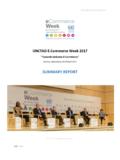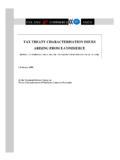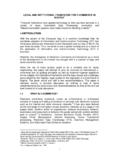Transcription of REPORT FROM THE COMMISSION TO THE …
1 EN EN EUROPEAN COMMISSION Brussels, COM(2017) 229 final REPORT FROM THE COMMISSION TO THE COUNCIL AND THE EUROPEAN PARLIAMENT Final REPORT on the E- commerce Sector Inquiry {SWD(2017) 154 final} 2 REPORT FROM THE COMMISSION TO THE COUNCIL AND THE EUROPEAN PARLIAMENT Final REPORT on the E- commerce Sector Inquiry 3 I. INTRODUCTION (1) On 6 May 2015, the COMMISSION launched a sector inquiry into the electronic commerce ( e- commerce ) of consumer goods and digital content in the EU ( e- commerce sector inquiry ).1 The e- commerce sector inquiry forms part of the Digital Single Market strategy adopted on the same (2) The Digital Single Market strategy outlines several key actions under three pillars through which the COMMISSION plans to create a Digital Single Market.
2 One of these pillars relates to ensuring better access for consumers and businesses to goods and services via e- commerce across the EU. (3) E- commerce in the EU has grown steadily in recent years. Today the EU is one of the largest e- commerce markets in the world. The percentage of people aged between 16 and 74 that have ordered goods or services over the internet has grown year-on-year from 30 % in 2007 to 55 % in (4) The rapid development of e- commerce affects consumers and businesses alike. The e- commerce sector inquiry allowed the COMMISSION to obtain an overview of the prevailing market trends and gather evidence on competition barriers linked to the growth of e- commerce .
3 It also allowed the COMMISSION to understand the prevalence of certain business practices and their underlying rationale, and ultimately to identify priorities for enforcing the EU competition rules. (5) For the purposes of the e- commerce sector inquiry, requests for information ( questionnaires ) were addressed to stakeholders between June 2015 and March 2016. 1 051 retailers ( retailers ); 37 marketplaces; 89 price comparison tool providers; 17 payment system providers; 259 manufacturers; 248 digital content providers; 9 companies offering virtual private networks4 and IP routing services; and 30 large groups and hosting operators,5 from 28 Member States, provided responses to the questionnaires.
4 Respondents submitted in total 2 605 agreements related to the distribution of consumer goods and 6 426 licensing agreements related to the distribution of digital content. 1 The sector inquiry was launched pursuant to Article 17 of Council Regulation (EC) No 1/2003 of 16 December 2002 on the implementation of the rules on competition laid down in Articles 81 and 82 of the Treaty, OJ L 1, , p. 1. 2 Communication from the COMMISSION to the European Parliament, the Council, the European Economic and Social Committee and the Committee of the Regions A Digital Single Market Strategy for Europe , COM(2015) 192 final.
5 For further details on the Digital Single Market Strategy, see 3 See 2016 Eurostat Community Survey on ICT usage in households and by individuals, available at: 4 A virtual private network is an encrypted communication channel that can be established between two computers or IP-based devices. 5 Operators which offer online content through agreements whereby such operators host service providers within a hosting environment with a specific set of characteristics, either via software ( hosting online operator ) or via hardware ( hosting device ). 4 (6) On 15 September 2016, the COMMISSION published a Preliminary Report6 on the initial findings of the e- commerce sector inquiry.
6 The publication of the Preliminary REPORT was followed by a public consultation open to all interested stakeholders. The public consultation ended on 18 November 2016. Altogether 66 submissions were made in relation to consumer goods and digital (7) Interested stakeholders also expressed their views at a stakeholder conference in Brussels on 6 October 2016. The event provided representatives of different stakeholders with an opportunity to put forward their views on the Preliminary REPORT . (8) This REPORT is accompanied by a Staff Working Document, the Final REPORT on the e- commerce sector inquiry ( the Final REPORT ) which summarises the main findings of the e- commerce sector inquiry and incorporates comments submitted by stakeholders during the public consultation.
7 The Final REPORT is divided into two separate sections: the first section covers e- commerce of consumer goods, while the second focuses on e- commerce of digital content. II. MAIN FINDINGS OF THE E- commerce SECTOR INQUIRY CONSUMER GOODS (9) The e- commerce sector inquiry covered the product categories most sold online: clothing and shoes; consumer electronics; electrical household appliances; computer games and software; toys and childcare articles; media (books, CDs, DVDs and Blu-ray discs); cosmetics and healthcare products; sports and outdoor equipment, and house and garden products. Respondents to the questionnaires could also comment on any other product categories.
8 (10) The results of the e- commerce sector inquiry confirm that the growth of e- commerce over the last decade had a significant impact on companies distribution strategies and customer behaviour. (11) First, price transparency has increased with online trade. Consumers are now able to instantaneously obtain and compare product and price information online, and switch swiftly from one channel (online/offline) to another. While this allows consumers to find the best deal online, it may also result in free-riding behaviour: consumers can use pre-sale services of brick and mortar shops before purchasing the product online.
9 Alternatively, consumers can search and compare products online before purchasing in brick and mortar Addressing free-riding and maintaining the incentives for 6 See SWD(2016) 312 final, available at 7 The list of the participants and the non-confidential versions of their submissions are available at 8 72 % of the manufacturers responding to the questionnaires explicitly acknowledge the existence of free-riding by online sales on offline services. 62 % acknowledge the existence of free-riding by offline retail on services (information) offered online.
10 Approximately 40 % of retailers also acknowledge the existence of free-riding behaviour both ways. Approximately 50 % of retailers declare they do not know whether such behaviour exists 5 retailers to invest in high quality services by creating a level playing field between offline and online are key considerations for both manufacturers and retailers. (12) Second, the ability to compare prices of products across several online retailers leads to increased price competition affecting both online and offline sales. While such increased price competition has beneficial effects for consumers, it may affect competition on parameters other than price, such as quality, brand and innovation.












